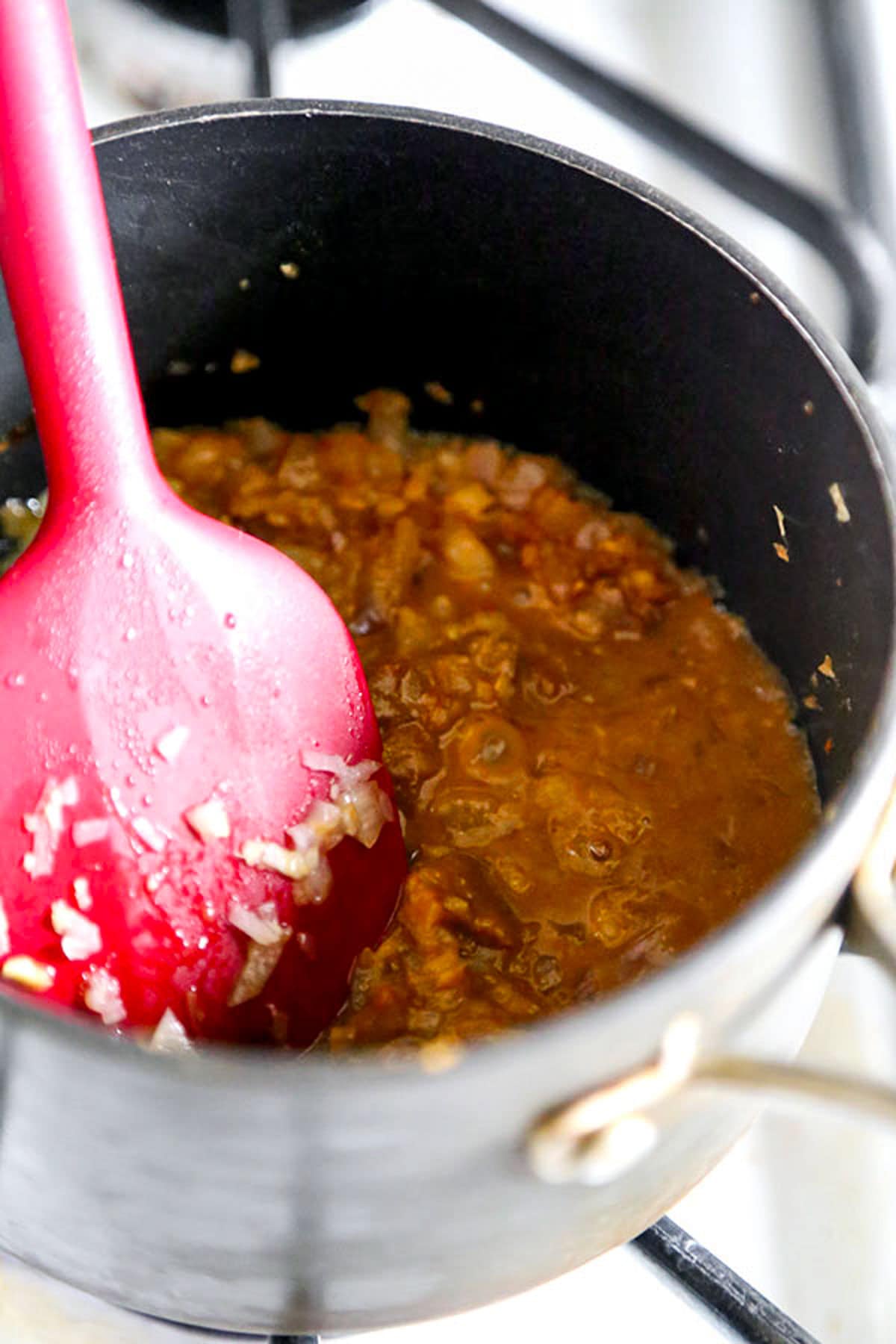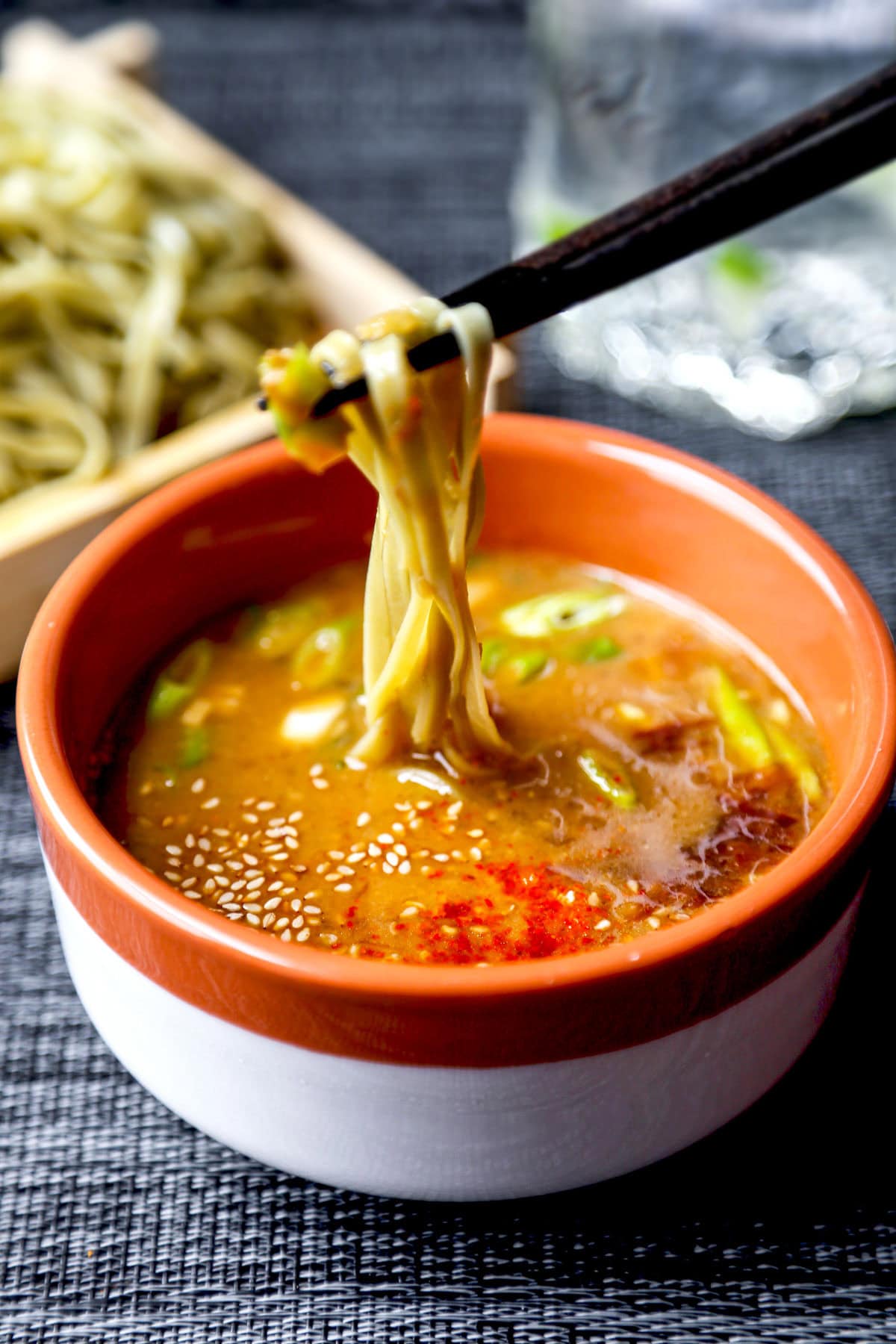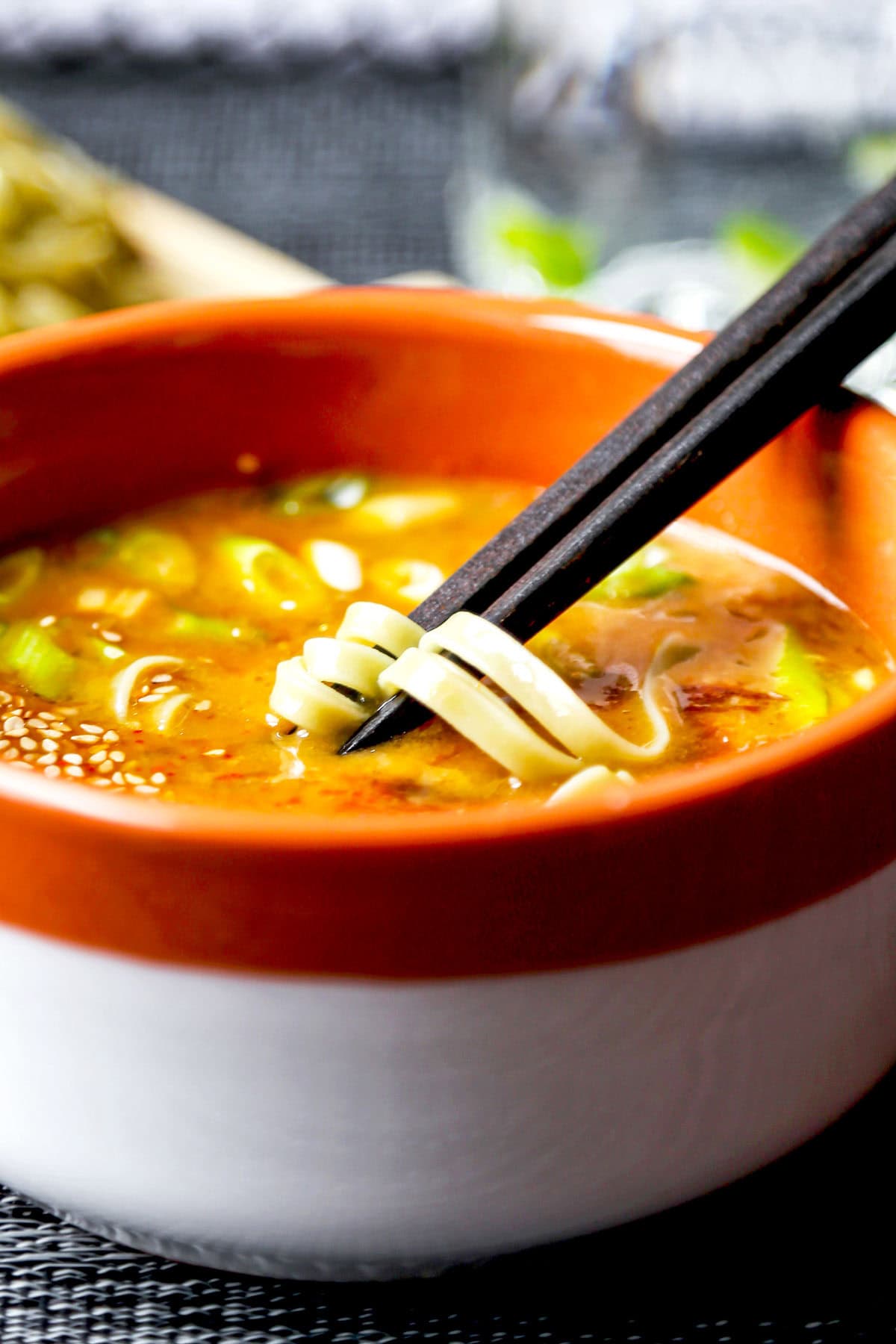My tsukemen recipe is served with a deeply flavored spicy miso broth that’s savory, nutty, and slightly sweet. This popular dipping noodle dish is one of my favorite meals to have after a long flight to the land of the rising sun. It’s both filling and comforting and satisfies my cravings for authentic Japanese flavors.

Tsukemen are Japanese dipping noodles. The main difference from the traditional ramen preparation is that, with tsukemen, the broth and noodles are served in separate bowls. The broth is more concentrated than your typical bowl of noodle soup because it isn’t meant to be drunk. Instead, the noodles are dipped in the sauce and enjoyed that way.
Why I Love This Recipe
Tsukemen is one of those dishes that can be enjoyed all year-long because it can be served hot or cold. The dipping sauce can be made ahead of time which makes it a convenient meal to have on days when my work schedule is so full I barely have time to cook. Once the dipping sauce is made, only the noodles need to be boiled before serving (they can also be boiled ahead of time but I prefer freshly boiled noodles over refrigerated ones). I love the strong flavors of this spicy miso sauce so much that I sometimes make extra to pour over a bowl of rice! Not only is my tsukemen recipe easy to make, it’s also healthy and low in calories.
Table of contents

Ingredients
- Noodles: The best noodles to use for this recipe are ramen, udon,and soba. I decided to try green tea udon noodles when I shot the dish but feel free to use any type of noodles you like. The only ones I suggest staying away from are the thin ones like somen noodles or thin rice noodles. That’s because the broth is rich and pairs better with thicker noodles.
- Dipping sauce: A mixture of 3 types of oil (vegetable oil, toasted sesame oil, chili oil), minced garlic, ginger, and shallot, miso paste, regular Japanese soy sauce, water, sugar, chicken stock, and sesame seeds.
- Toppings: Chopped scallions for a refreshing sweet crunch, bonito flakes to add a briny element, and ichimi togarashi (red chili pepper) for extra heat.
Best Miso Paste For This Tsukemen Recipe
For this recipe, I recommend using awase miso paste because its both salty and a little sweet. Awase miso paste is a mixture of white miso paste and red miso paste. While I do prefer using white miso paste when making miso soup (the flavors are more delicate), awase miso paste pairs beautifully with this recipe because it has a stronger taste, although not as intense and robust as red miso paste.

How To Make It
- Start by frying the spices (garlic, ginger, shallot) in a little oil until they begin to soften.
- Add the miso paste and other seasonings for the sauce – except for the chili oil and sesame oil – and reduce it by simmering for 15 minutes, uncovered. Turn the heat off and stir in the flavored oils.
- Boil the noodles until desired consistency and rinse them under cold water. Drain them again and place on serving plates.
- Split the spicy miso sauce among 2 bowls and add the toppings. Serve the sauce with the noodles and enjoy!
Expert Tip
To keep the noodles from sticking together, toss them in a little sesame oil. This way you can make the noodles ahead of time as well and won’t have to worry about them becoming a clumpy mess.
Storage And Reheating
- Fridge: Save the sauce in an airtight storage container. If you are cooking the noodles ahead of time too, save them separately in another airtight storage container. Refrigerate for up to 5 days.
- Freezer: Good news, the sauce can be frozen! Simply let the sauce cool to room temperature first and transfer it to an airtight storage container or storage bag. Freeze for up to 2 months. I don’t recommend freezing cooked noodles as the texture of the noodles will deteriorate. To thaw the sauce, take it out of the freezer and let it sit in the fridge overnight.


What To Serve With Tsukemen
In Japan, tsukemen is usually served as a main dish and can be accompanied by small sides. Some of the popular sides – and some of my favorites – that I like to pair with this recipe are:
- Ajitsuke tamago (ramen eggs)
- Mushroom and cabbage dumplings with dumpling sauce
- Inari sushi
- Edamame with soy and sesame sauce
- Nasu dengaku
- Japanese cabbage salad
Frequently Asked Questions
It depends on the miso paste you buy. While most miso pastes are vegan, it’s important to note that some of them may contain dashi. Therefore, always look at the label and the ingredients to make sure that the miso paste you are buying is 100% vegan.
No, this recipe isn’t gluten-free. Ingredients in this recipe that contain gluten are – soy sauce, miso paste (some of them are gluten-free), and noodles. However, it’s very easy to make this recipe gluten-free! Simply swap regular soy sauce for gluten-free soy sauce or tamari sauce, use gluten-free miso paste, and gluten-free ramen noodles.
You don’t have to use regular Japanese soy sauce to make this recipe, but I don’t recommend using Thai or Vietnamese soy sauces because they tend to be quite sweet. Japanese soy sauce has the perfect balance of salty, sweet, and umami. Chinese and Korean soy sauces are closer in taste to the Japanese kind and therefore are interchangeable.
Other popular ramen recipes you might like: spicy miso ramen, kimchi miso ramen, shio ramen, shoyu ramen, hiyashi chuka, miso ramen, vegetable champon, and jajamen.


Did you like this recipe? Are there changes you made that you would like to share? Share your tips and recommendations in the comments section below!
Print
Spicy Tsukemen (Dipping Noodles)
- Prep Time: 7 minutes
- Cook Time: 18 minutes
- Total Time: 25 minutes
- Yield: 2 servings 1x
- Category: Noodles
- Method: Boiling
- Cuisine: Japanese
- Diet: Vegetarian
Description
A cooling and summer-perfect dish of chilled noodles served in a spicy miso dipping sauce. This tsukemen recipe is ready is 25 minutes from start to finish.
Ingredients
- 6 ounces dry ramen noodles, udon noodles, or soba noodles
Dipping sauce
- 1/2 tablespoon vegetable oil
- 1 clove garlic, minced
- 1 small shallot, minced
- 1 tablespoon ginger, peeled and minced
- 2 tablespoons white miso paste or awase miso paste
- 1 tablespoon regular Japanese soy sauce
- 1 1/2 cup water
- 1 teaspoon granulated sugar
- 1 teaspoon powdered chicken stock or vegetable stock
- 1/2 teaspoon chili oil
- 1 teaspoon toasted sesame oil (optional)
- 1 tablespoon sesame seeds
Toppings
- 2 scallions, chopped on the bias
- 2 tablespoons bonito flakes (optional)
- Ichimi togarashi, to taste
Instructions
- Fry the spices: In a pot over medium low heat, add the oil, garlic, ginger, and shallot. Cook for 2 minutes, stirring frequently until the shallots are translucent.
- Add the miso paste: Stir in the miso paste and soy sauce and cook until the mixture turns into a soft paste.
- Add some seasonings: Add the water, sugar, and chicken stock. Stir and bring the mixture to a boil.
- Reduce the sauce: Lower the heat to a simmer and leave uncovered for 15 minutes.
- Add the flavored oils: Turn the heat off and add the chili oil, toasted sesame oil, and sesame seeds.
- Cool the spicy miso sauce: Transfer the sauce to a storage container and let it cool to room temperature. Refrigerate for at least 1 hour.
- Boil the noodles: Cook the noodles according to the directions on the package. Drain and rinse them under cold water. Drain them again and divide the noodles among two serving plates.
- Assemble the dish and serve: Divide the spicy miso sauce among two bowls and top with scallions, sesame seeds, and bonito flakes. Serve with the noodles. To eat, take a small amount of noodles using chopsticks and dip them in the sauce.
Notes
To make the dipping sauce ahead of time: Save it in a storage container and refrigerate for up to 5 days. Tsukemen can be served hot or cold.
Nutrition
- Serving Size: 1 serving
- Calories: 264
- Sugar: 3.2g
- Sodium: 549mg
- Fat: 10.4g
- Saturated Fat: 1.1g
- Unsaturated Fat: 3.4g
- Trans Fat: 0g
- Carbohydrates: 36.6g
- Fiber: 1.8g
- Protein: 4.1g
- Cholesterol: 1.1mg















Made this last night to rave reviews from the family. Thank you for the recipe.
Thank you Carrie! 🙂
This is really tasty and easy! First attempt and will use it again.
Thank you Tina :)!
Wonderful flavorful recipe! The chili oil and sesame oil put it over the top! Served this to my friend/neighbor at room temp on the rooftop garden tonight (that’s what we do in NYC!)
A total success! Thank you, Caroline!
Thank you so much Jeana!
Tasty, quick little dinner that you will have everything on hand for if you cook Asian fair regularly. My chili oil is Fly by Jing and the flavors melded beautifully. Used shrimp seasoned with schichimi togarashi for protein with a little kick. This recipe really hit the spot! I bet with a dollop of peanut butter it would be over the top!
I made this noodle dinner tonight and paired it with chicken katsu. It was a winner. The kids also loved the salad with ginger carrot dressing! I can honestly eat this every night! Thx for the wonderful dinner ideas. Hubby wants to know if there’s other flavours of dipping sauce for the noodle ?
Hi Jenn! Yes there are lots of different flavors to enjoy with tsukemen! You can easily tweak the recipe and add your own twist. You could add a block of Japanese curry roux to it, a splash of rice vinegar to lighten up the taste, etc… So many to choose from! 🙂
Caroline, this looks awesome. I am new to Korean cooking so have a
question. The recipe calls for Miso. I have red, white and yellow Miso
paste but you don’t say what kind of Miso. Is there a powdered Miso
that I am not aware of? I’m looking forward to making this as soon as
possible!
Hi Terri! You can use any type of miso paste for this recipe, they all work really nicely 🙂
I just cooked this for my fiance and I, and it was delicious! It was so easy to make but still tasty, thank you! I substituted dashi for the chicken stock, half an onion for the shallot. It went well with chicken katsu. I accidentally simmered down the stock a bit too long but you can always adjust the saltiness with more hot water.
I cooked this with some changes (minced white part of two scallions instead of shallot, no garlic, a little packet of dashi instead of powdered chicken stock) and ate it with somen and kimchi on the side. It’s really good and I immediately sent the recipe to my sister.
I also like that this recipe makes “only” two servings because I live alone and don’t like filling my very small fridge with lots of leftovers. Looking forward to eat the second serving tomorrow!
I made this but substituted dashi for the water and powdered chicken stock, I also added seven spice for a kick, skipped bonito flakes because of the dashi. It was wonderful, thank you for this recipe.
How spicy is this if you go precisely by the instructions? Can someone who normally orders a 1 on the Thai spice scale handle this soup?
Hi Christie! I don’t find this recipe spicy – Japanese people can’t handle spicy food so their version of spicy is never hot – but if you are really sensitive you can omit the chili oil and the dish won’t have any heat 🙂
Just tripled this and made it for my family of 7 on Friday and they loved it. Great recipe.
Thank you much…so many times i tried your recipes…it was amazing …thanks again…
Thank you Ayeesha! 🙂
Looks great would like to try it. If you’re using liquid stock instead of powdered, how much should be used?
Hi Sean! Use 1 1/2 cup of liquid stock and skip the water 🙂
OMG! I’m reading this at midnight and I’m so hungry!
http://beautifullyme.in/
I am so excited to try this Caroline. Japan sounds amazing & I look forward to one day going there for a foodie experience. I’ve pinned this for later reference – I really can’t wait to try this at home 🙂
https://missfoodfairy.com/2016/10/05/in-my-kitchen-october-2016/
Thank you Nicole! 🙂
Caroline, so far I have tried, Krave beef jerky pineapple Orange,,Krave Pork Jerky Black Cherry Barbecue, Krave Pork Jerky Grilled Sweet Teriyaki. Krave Beef jerky Sweet Chipotle and Krave Beef Jerky Pineapple Orange L OVE every one of them. Once again thank you for drawing my name that I might receive your gift..
I do love to read all of your recipes and try some
Thank you Thomas!